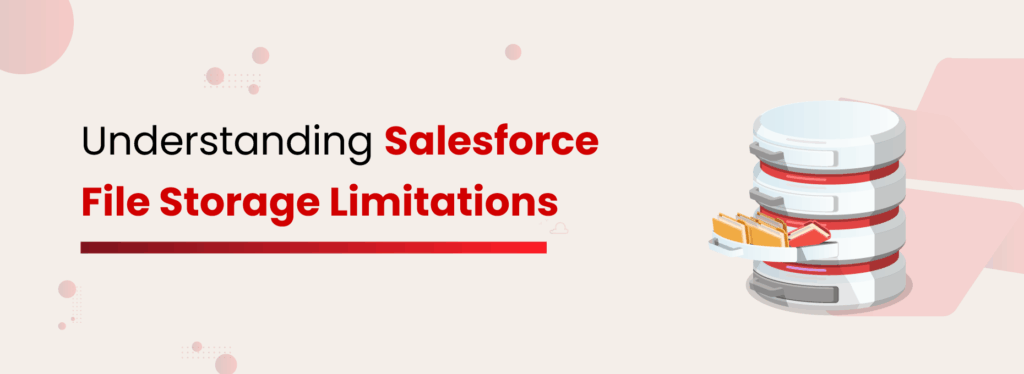Understanding Salesforce File Storage Limitations

Over the past two decades, Salesforce has established itself as the leading CRM provider worldwide. Thousands of businesses, both large and small, across various industries have used it to enhance their sales and service processes. Salesforce offers numerous benefits that contribute to consistent and smooth performance. However, some functionalities are limited to maintain high performance and reliability. And one of the most noticeable limits is related to file storage. In this blog, we’ll take a closer look at Salesforce’s file storage limits and explore some of the key challenges businesses often face. How Salesforce File Storage Works Whenever users upload, generate, or receive files, such as documents or email attachments, in Salesforce, those files are stored in the platform’s primary storage. This applies to both standard and community users. By default, Salesforce provides 10 GB of file storage per org for editions like Contact Manager, Group, Professional, Enterprise, Performance, and Unlimited. The Essentials edition, however, includes only 1 GB per org. On top of this base storage, additional file storage is allocated per user license, depending on the edition. Enterprise, Performance, and Unlimited editions receive an extra 2 GB of storage per user license, while Contact Manager, Group, and Professional editions get 612 MB per user license. If you’re interested in understanding Salesforce file storage pricing in detail, be sure to check out the comprehensive breakdown available. Common Challenges with Salesforce File Storage Salesforce enforces specific limits on file sizes and sharing to ensure smooth platform performance and data security. These limits impact your storage management and collaboration workflows. Therefore, knowing them helps you plan smarter and avoid surprises. Salesforce File Size Limit Salesforce doesn’t only have limited storage space – it also restricts the size of individual files that can be stored within the app. Below are the file size limits: Salesforce Files (like files in libraries, Chatter, and on records): up to 2 GB per file Attachments (on records in Lightning Experience): up to 2 GB per file Documents, Knowledge Attachments, and Chat files: up to 5 MB per file So, even if you have enough storage overall, some files might be too big to upload. It’s important to keep these limits in mind when managing your files. Salesforce File Sharing Limits Apart from the above limits on storage and size, there is also a limit on how many times a file can be shared. This stands at 2,000 times, including sharing with records, people, and groups. Consequences of Ignoring Salesforce File Storage Limits For businesses generating a high volume of files or large-sized files within their Salesforce environment, running out of allocated file storage is inevitable. As storage nears its limit, users like sales reps and service agents begin to face delays and disruptions in their daily operations. Uploading new files becomes a challenge, leading to slowed workflows, hindered customer service, and, in severe cases, a breakdown in core business processes. To make matters worse, purchasing additional storage from Salesforce can be expensive. There’s also the issue of file accessibility; anyone with the link can view a file, even if they’re outside the Salesforce team, posing serious risks for sensitive or private information. Exceeding Salesforce file storage limits doesn’t just affect performance; it increases costs and security concerns. How to Get Around the Salesforce File Storage Limitations? Once you encounter the above challenges, it becomes essential to seek possible solutions to prevent exceeding your Salesforce storage limits. When you analyze all the options, you can categorize them into three main categories: Option 1: Purge some old files to optimize your storage Option 2: Upgrade storage by paying an additional cost to Salesforce Option 3: Move files to a relatively low-cost and long-term external storage space without losing access to your files If you are considering the first option, deleting older files from the org, it is advisable to consult the compliance team. In many cases, internal policies and regulatory requirements prohibit the deletion of data and mandate long-term retention. Hence, file deletion is rarely a sustainable solution, as ongoing business growth will continuously generate more data. The second option, purchasing additional storage from Salesforce, also presents challenges. The added storage cost is significantly high, and frequent upgrades put a strain on the IT budget. The Smart Way Forward: External File Storage Integration If you’re looking to manage

